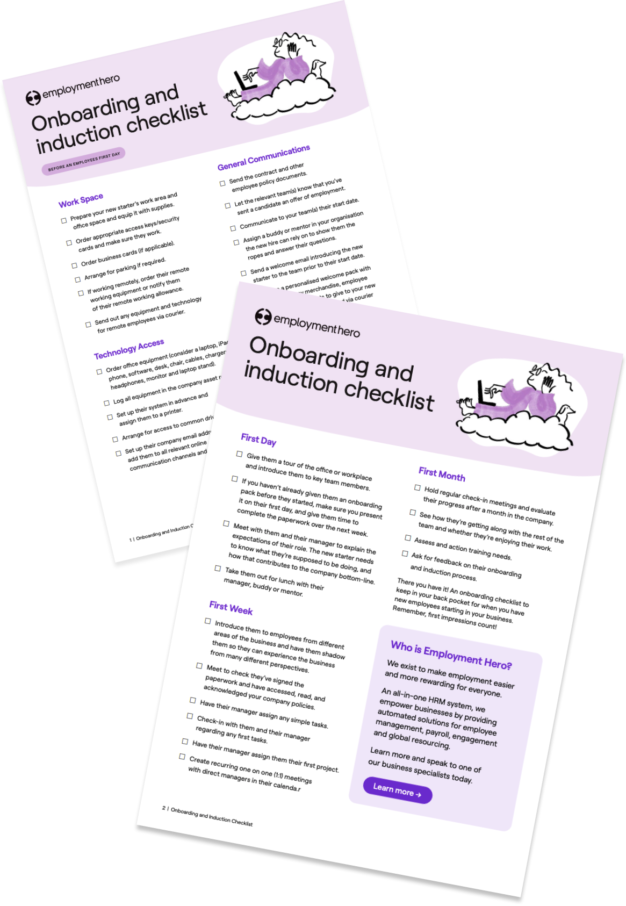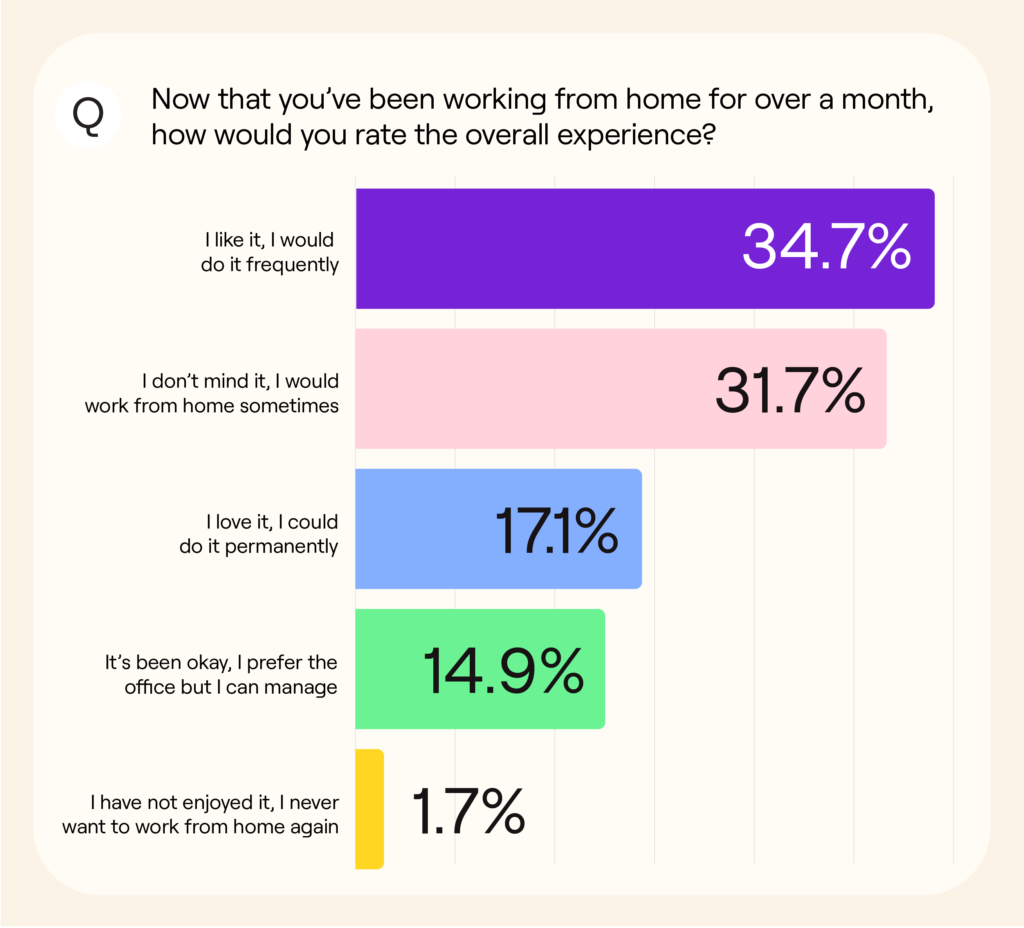
Give your new employees a great first impression with this onboarding and induction template.
Our onboarding and induction template includes everything you’ll need to create a standout employee induction experience your new starters will remember for all the right reasons.
Using this new employee induction checklist, you can help new employees:
- Get prepared for their first day, week and month
- Cover all bases when it comes to setting up their workspace, technology and communications
What’s included in the employee induction and onboarding checklist template?
- Preparing your new starter’s workspace
- Making sure they have access to all the tools for their new job
- Providing them with important details of the company
- Introducing and welcoming new employees to their team members
Download our onboarding and induction template now.
To further enhance your HR processes, explore our guide on taking HR digital and discover the range of benefits it offers.

Who is this resource for?
HR Professionals – If you’re running an HR team, or contributing to HR success, this new starter HR onboarding checklist could be incredibly helpful. Print out and use this HR checklist to use as your own, or use it as a base to cross-check your current new hire onboarding checklist.
Employers – If you’re running a small to medium-sized business, you may not have a dedicated HR team to tick off every onboarding task. This onboarding process checklist is perfect for helping you easily follow along with your new hire’s journey through onboarding and induction.
For small business owners, our Small business guide to hiring new employees provides comprehensive information on the hiring process.
Hiring Managers – While your HR team or employer may have hired your new direct report, direct managers will ultimately be the ones ensuring that the practical items in the onboarding plan are checked off. This onboarding checklist can help you make sure that nothing is missed as your new hire gets started.
If kept in an easy-to-access place (online or offline), this onboarding template can also help you collaborate with other employees on an onboarding process. Together, you can monitor an employee’s progress and reduce double-handling of tasks. It’s a great way to keep everything in check (literally).
New to HR? Our Introduction To Managing Human Resources guide is perfect for beginners looking to understand the basics of HR management.
What is an induction process?
An induction process is where the new employee does the bulk of their learning about the business and their role within it. It’s generally a learning process, where the employee is taught about the company by those inside the company (building on any information they may have learned during recruitment), and is a chance to share insider information about goals and plans to help the employee prepare ahead.
Induction can also include the sharing of information about company policies, team structure and a person’s role.
Confused about the difference between onboarding and induction? Although the terms are sometimes used interchangeably, we suggest that an induction plan can be considered part of the onboarding process, but onboarding is not part of an induction process. To learn why, let’s define onboarding.
What is an onboarding process?
Onboarding is a much bigger process than people realise. It includes setting an employee up in different systems, organising their equipment, introducing them to their new team members, establishing goals… The list goes on.
If you’re eager to learn more about the world of onboarding, consider downloading our ultimate employee onboarding guide and become a master of this essential part of employment.
What is the purpose of an onboarding checklist?
Why use a new employee onboarding checklist? In short – it can help you make sure that nothing gets missed in the complex process that is onboarding your new hire!
Onboarding can stretch out from before an employee’s first day to after an employee’s first month. There’s a lot of tasks for the new employee, employer and manager – so it’s well worth keeping track of what has and hasn’t been done.

What else should be considered in the onboarding process?
While onboarding checklists get specific about the tasks you need to complete in onboarding, here are a few things you should consider when onboarding new employees to create a meaningful and efficient process.
1. Your company culture
Employees are more likely to invest themselves personally in a company’s success if they feel aligned with the business. It’s essential to get your new employees involved in your company’s culture on day one. The best way to do this is for new hires to spend time with employees from different areas of the business with various levels of seniority.
Likewise, implementing an onboarding buddy system ensures your new hire has someone to talk to, which is so important in the first nerve-wracking weeks of a new job.

2. Company mission, vision and goals
If you want your new starter to embody the company’s mission, vision and values, then you need to share this as part of your onboarding process and show them where the business is headed.
It’s equally important for everyone to understand their own goals and how they relate to the big picture. Communicating the goals of their role during the onboarding process will help new hires focus their efforts on achieving them.
3. Introduction to key team members
Getting to know all the new faces and personalities in a business can seem daunting at first. Your role is to help new employees settle into their new team and get to know the clients, colleagues, managers, etc. they will work with to become recognised and integrate naturally.
4. Sharing an employee handbook
Induction and onboarding can cause a bit of information overload for your new hire. While there’s a lot to be communicated, you should also consider distributing an employee handbook with all of the relevant information you’ve shared in the onboarding and induction process.
Having access to an employee handbook can take some of the pressure off having to retain such large amounts of information, and allows a new employee to access important details in their own time.
Sections of an onboarding checklist
Why have we split our onboarding checklist into sections? Well, apart from making it easier for the reader to digest each collection of tasks – it can help us identify key parts of this important process.
Rather than thinking of onboarding as a one-day orientation, think of it as a continuum: a process that lasts anywhere from 3 to 12 months. Let’s break down these sections and why we’ve included them in our onboarding checklist.
Pre onboarding
Pre onboarding can cover a person’s workspace, technology access and initial communications. Let’s start with workspace; it’s where your new employee is going to be spending the majority of their time, after all! It’s a key part of the pre onboarding experience.
Where should someone be spending their time while they are working for the business? Will this be an in-office, remote or hot-desking working environment? How will the person be positioned to communicate with their team and different departments as a new arrival? We’ve covered everything you need to check off.
Technology Access
Is there anything worse than trying to navigate new technology on your first day? In our new hire checklist we cover everything to make sure that an employee’s tech is ready to roll and they can hit the ground running.

First day
The hottest part of the onboarding process! An employee’s first day with a business can make or break for a good onboarding. It’s full of important moments, and can often be the source of a lot of anxiety for your new hire if not done well.
Day one of a new hire’s employment will have a selection of important tasks, which start by organising a great welcome package and go from there. There are lots of things to check in on and specific details to share. Are you across them?
First week
The first week is an important time for a new employee to get involved in workplace social events, understand a company’s expectations and to begin work under their new job title. In our onboarding checklist we go through the elements that can bring this all together.
First month
Now we’re up and running, your new hire can start to think more strategically about their goals, any additional training they might need and their probation period.

The five phases of employee onboarding
Instead of thinking about an employee onboarding in terms of periods of time, another way of approaching it is with these five phases. This can also help ensure a smooth onboarding process, when used alongside our new hire onboarding checklist template.
Phase one: New hire paperwork
The first phase is about the employee’s pre-arrival to ensure that they have a seamless integration into the business.
One method of doing this is getting all the necessary hr documents for new employees out of the way i.e. their employment contract, payroll forms, legal documents and any other work requirements.
If you’re looking for a HR software that can help you onboard your employees digitally, we’ve put together this handy guide to help you choose the perfect HRIS for your team.
Phase two: A new environment
Phase two focuses on making the employee feel welcome and comfortable in their new environment with a great company culture.
Just like first impressions, a new employee’s first day is important in setting the tone for their experience with the business. Both yourself and other members of the team can make small gestures to ensure a warm welcome.
Phase three: Employee training
The third phase is about being conscious to not overload your new hire with information.
Try to think back what it was like on your first day and all the new things (and names) you had to remember. Therefore, don’t try to hurry over the new employee checklist; instead, extend all the training processes over the first month — everyone learns at a different pace.
Phase four: Goal setting
Phase four is where you implement your training program so new employees can learn everything they need to do their job well. This is also a time for you to have a discussion with your employee and set goals.
Phase five: Job performance feedback
Be sure to give feedback, not only for recognition of the work they have done but to give them a chance to improve. Following up and checking in even after the training is done is just as important to track their progress and performance. Don’t forget to seek onboarding feedback too!

Onboarding FAQs
1. How do you speed up the onboarding process?
Usually, hiring new staff comes with a mountain of onboarding paperwork. But that doesn’t mean your new starter’s first day should be all about filling in forms.
To ensure your onboarding process helps set up your new starter for success, get all the paperwork out of the way quickly and efficiently with a paperless onboarding solution like Employment Hero. Completing all the paperwork days or even weeks before the new employee starts, ensures day one is more enjoyable.
2. What do new hires want from onboarding?
Onboarding can make or break how a new employee perceives their company and how productive they will be. So it’s important that you think about the needs of both your business and employees throughout the onboarding experience. To find out more, we’ve included the results from a survey LinkedIn did on what new hires want during onboarding:

Source: LinkedIn
What do these results tell you about your current onboarding program? In what ways could you improve it to meet your new employee’s needs?
3. How can onboarding improve employee engagement?
Employee engagement is one of the most important factors in achieving overall business success and greater productivity. By investing the time and energy into developing your onboarding program, you can use it as a means to boost employee engagement.
Certain elements of onboarding can do just this for your new hire. For example, building strong relationships between your new talent and management and reinforcing the business’s commitment to supporting an employee’s professional growth.
4. How does onboarding experience impact employee performance?
There’s a lot to take in when starting at a new company, so it’s your responsibility to make sure new employees feel settled with their new team as well as introduce them to fellow colleagues or managers they will work with.
An effective employee onboarding program can make the difference on the longevity of an employee’s performance, with 82% of recruits being more likely to stay with their new company for three years. Effective programs are also known to contribute to an 11% increase in employee performance.
5. How can HR evaluate the success of an onboarding program?
There are several ways for HR to evaluate the success of your program. Both qualitative and quantitative measurements can be used, so we’ve listed a couple to get you started:
- Employee feedback– Surveys are always a great option to gather valuable feedback. Some questions to ask could be surrounding role clarity, self-evaluation on their competency, social integration, knowledge of company culture. Interviews are also useful for receiving detailed feedback from both new hires and those leaving the business.
- Retention rates – Ongoing measurement of turnover rates allows an organisation to compare with years past. High turnover could be a reflection of your onboarding process and can cost an organisation up to 300% of the replaced employee’s salary.
- Performance and productivity goals – this is something you should discuss with your new employee in the early stages of onboarding. Having goals that are time bound can make this process easier.
6. How is remote/virtual employee onboarding done?
With remote work gaining popularity among employees, remote first working will become an expectation for many employees (see the results from our survey below). Find out how with our remote onboarding checklist.

Source: Employment Hero Remote Work Survey
Want to learn more about our onboarding tools?
You’ve learned a lot about onboarding today, and you’re ready to go with your employee onboarding checklist, but what about your onboarding software?
Our paperless onboarding features, complete with digital employee onboarding checklist tools, can make all the difference in creating an effective onboarding process.
Speak to our business specialists today about our helpful HR tools, and book a demo to see them in action.

